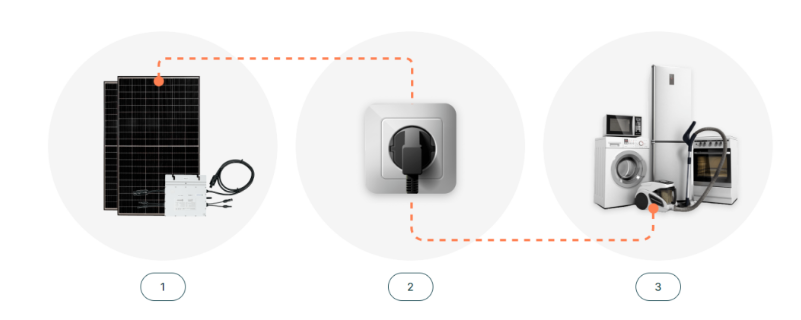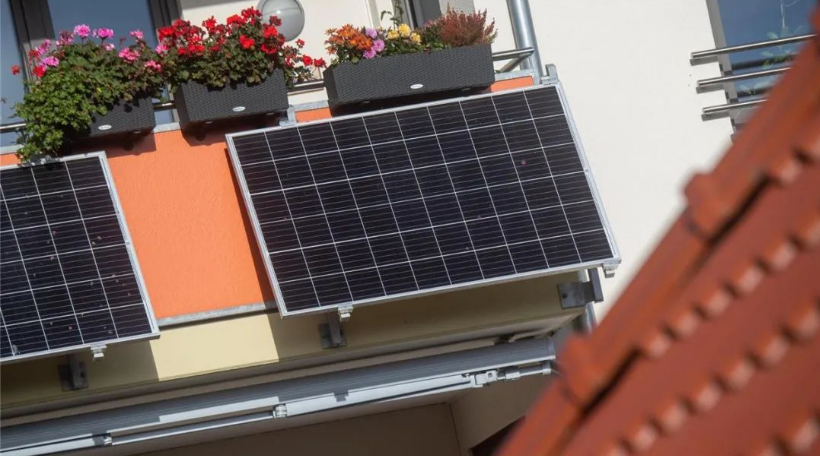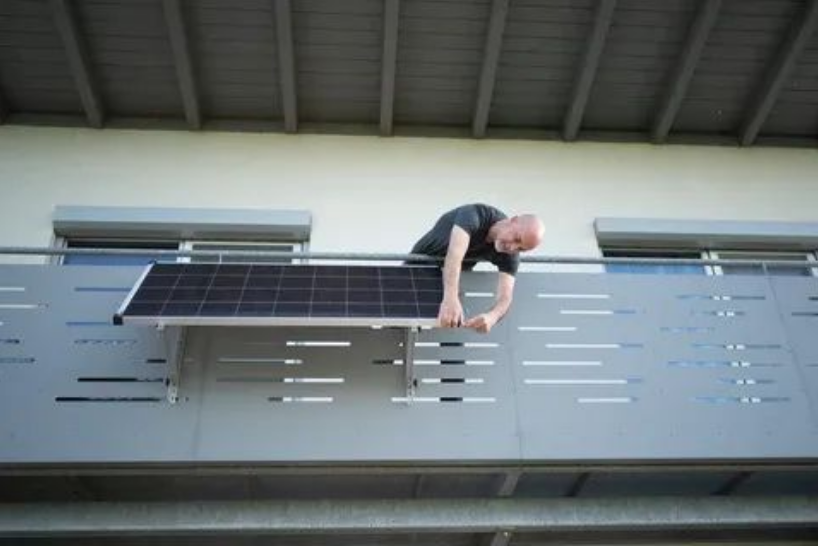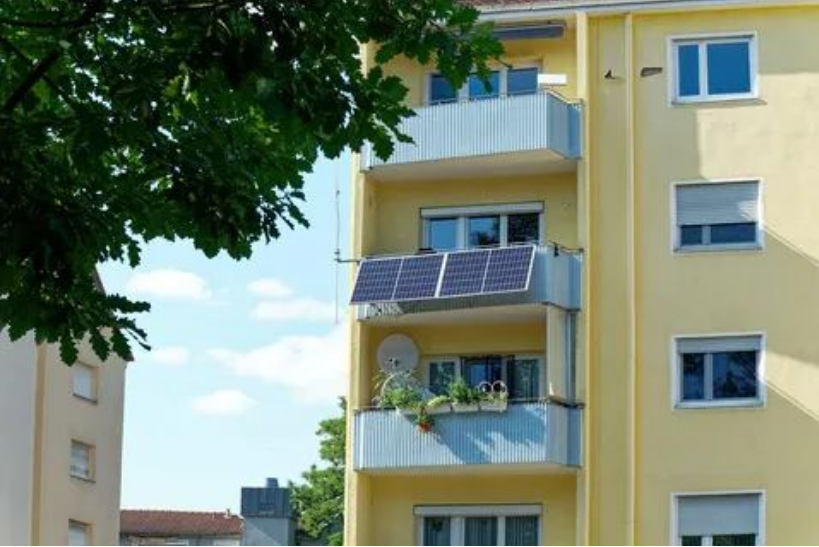
- English
- Español
- Português
- русский
- Français
- 日本語
- Deutsch
- tiếng Việt
- Italiano
- Nederlands
- ภาษาไทย
- Polski
- 한국어
- Svenska
- magyar
- Malay
- বাংলা ভাষার
- Dansk
- Suomi
- हिन्दी
- Pilipino
- Türkçe
- Gaeilge
- العربية
- Indonesia
- Norsk
- تمل
- český
- ελληνικά
- український
- Javanese
- فارسی
- தமிழ்
- తెలుగు
- नेपाली
- Burmese
- български
- ລາວ
- Latine
- Қазақша
- Euskal
- Azərbaycan
- Slovenský jazyk
- Македонски
- Lietuvos
- Eesti Keel
- Română
- Slovenski
- मराठी
- Srpski језик
Photovoltaics on German balconies is becoming increasingly popular
2023-08-26
While shopping at your local supermarket in Germany, you can buy a 600W solar system, take it home, install it on your balcony, plug it into a power outlet, and just like that, a small household power plant starts running.
Thanks to the sharp rise in electricity prices, this kind of balcony power generation system that can be purchased through supermarkets or the Internet is becoming more and more popular. The number of small solar power systems has doubled this year. According to the market master data register of the Federal Network Agency, there are currently about 230,000 plug-and-play photovoltaic power generation devices in Germany, of which nearly 137,000 devices, or more than half, were put into use this year.

The number of systems may be higher. According to the Federal Network Agency, there are about 30,000 other systems with an output of less than 1 kilowatt on the register, and it is unclear whether these are also balcony power plants. In addition, an unknown number of systems are unregistered and not registered with the electricity provider.
What is balcony photovoltaic?
The balcony photovoltaic system is called "balkonkraftwerk" in Germany. As the name suggests, it is to install a photovoltaic system on the balcony. It is an ultra-small distributed photovoltaic system, also known as a plug-in photovoltaic system. Users only need to fix the photovoltaic system on the balcony railing and plug the system cable into the socket at home. A balcony photovoltaic system usually consists of one or two photovoltaic modules and a micro-inverter. The solar modules generate direct current, which is then converted to alternating current by an inverter that plugs the system into an outlet and connects it to the home circuit.
Balcony Photovoltaic Working Principle

In Germany, supermarkets sell balcony photovoltaic systems exempt from VAT, and the price is about 500-700 euros, but in some cities, most of the costs are borne by the local government. For example, the tax rebate for a single family in the German state of May is up to 500 euros. The average German household consumes 3500kWh of electricity per year. According to the data of North Rhine-Westphalia Consumer Advisory Center in Germany, a 380W balcony photovoltaic system installed in the south can provide about 280kWh of electricity per year. This is equivalent to the annual electricity consumption of a refrigerator and a washing machine in a two-person household.

Users use two systems to form a complete set of balcony photovoltaic power plants, which can save about 132 euros per year. On sunny days, the system can meet most of the electricity needs of the average two-person household. In a time of massively rising energy prices, small solar installations that are easy to install can quickly pay for themselves.
To sum up, balcony photovoltaic has three main notable features: simple installation, plug and play, and low cost.
Promote "PV for All"
While the costs and savings of individual installations are largely negligible, 'balkonkraftwerks' could make a huge contribution to the energy transition in the context of the Russia-Ukraine crisis. Thus, the German government wants to further simplify the installation of equipment, thereby driving the market to grow significantly.
Last week, the German Federal Cabinet adopted a new photovoltaic development package to help consumers remove obstacles to installing photovoltaic systems on balconies, saying that the corresponding law is expected to be discussed in parliament in the autumn and may come into force in early 2024. The German government sees it as part of citizen participation in clean energy generation.

Currently, photovoltaic installations on balconies must be registered in the market data register of the Federal Network Agency and reported to the network operator. In order to simplify the process, in the new plan, the government grants apartment owners and even tenants the right to install these devices without first consulting the landlord committee in the building; families will no longer need to register with the grid operator or register with the grid operator before installing solar panels on their balconies. Install two-way electricity meters; it is clear that the upper limit of the approval-free capacity of small photovoltaic systems in Germany will be raised from 600 watts to 800 watts.
It is worth noting that the German Solar Industry Association (BSW) expects that the share of plug-and-play solar installations in meeting Germany's electricity demand will remain relatively small for the foreseeable future. However, these devices allow many people to actively participate and share in the energy transition process, "thus also increasing the acceptance of renewable energy", emphasizes Carsten Körnig, president of the association.

The advantage of this type of equipment is its technical simplicity and low procurement cost, making it an entry option for tenants and apartment owners into their own solar power generation. Whether such a system is cost-effective depends on the procurement price and electricity price and whether the components are available for as long as possible. Get as much sunlight as possible.
In Germany, the distribution of devices registered in market data registers is uneven. Balcony PV systems seem to be especially popular in northern Germany. In Meiqian Prefecture, about 5 devices are installed for every 1,000 residents. Last year, the state allocated 10 million euros to support the installation of solar modules with a power of up to 600W on balconies, terraces and facades, and each household is entitled to a subsidy of up to 500 euros. There are 4.2 in Schleswig-Holstein and 3.8 in Lower Saxony. However, the southern states of Bavaria and Baden-Wurttemberg are around 2.7 units. below the German average.

In general, although "balcony power plants" account for a small share of Germany's overall energy supply, the influence of these devices is still limited, but as the German government further simplifies the installation procedures and promotes changes in energy policies, "balcony power plants "There will be greater potential and influence in the future. At the same time, their popularization may also push down the price of electricity to a certain extent, reducing the living pressure of residents under inflation.



